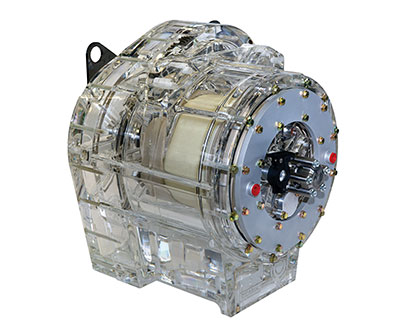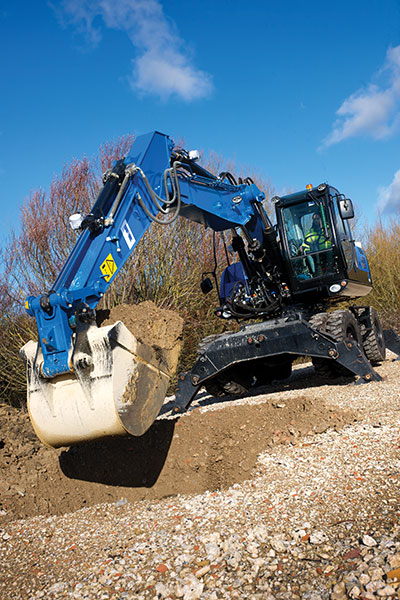
A new spin saves energy
By Jack Kohane
Features Products Tech tipsPeople have relied on this little device to harvest and store energy for use in the immediate future, opposite in principle to using wheels to harness energy sources into moving cars, trucks and trains forward.
People have relied on this little device to harvest and store energy for use in the immediate future, opposite in principle to using wheels to harness energy sources into moving cars, trucks and trains forward. Now a revolutionary idea has come along that propels the flywheel into the 21st century to answer our growing energy-saving needs.
 |
|
| Flywheel energy storage is not a new idea, but Ricardo’s innovative magnetic gear interface is. It allows the flywheel to be permanently sealed under vacuum, allowing for very high rotation rates and an acceptable life span.
|
Debuting the latest generation of its flywheel energy storage at the recent ConExpo 2014 show in Las Vegas, Ricardo, a leading global provider of product innovation and engineering solutions, showcased its pre-production prototype called TorqStor, designed to provide a range of low-cost energy storage capacities in the construction sector.
“We are going to store energy by speeding up the flywheel, and recover energy that is released from any vehicle changing motions,” says UK-based David Rollafson, vice-president of innovation for Ricardo. “The faster the flywheel spins, the more energy it has,” he enthuses.
As an example, Rollafson says a conventional construction site excavator equipped with a new TorqStor device could save as much as half of the total potential energy that is currently wasted in the machine’s arm/bucket movements. Coupled with further improvements to the base machine, such as engine downsizing, hydraulic system improvements, and ancillary load optimization, fuel savings could be substantially greater.
Offering an array of energy storage systems, from super capacitors to electric hybrids, Rollafson says Ricardo believes the high-speed flywheel offers a low cost approach to achieving real-world fuel savings in construction equipment operations. How does it work? If you spin a flywheel, it stores energy by virtue of its rotation – kinetic energy. Hence they’re sometimes called ‘KERS’ systems (for kinetic energy recovery systems). When there’s energy to be recovered (rather than wasted) in a vehicle’s drive cycle, it’s used to spin up the flywheel. The flywheel stores the energy as rotational energy, meaning as more energy enters the flywheel, the flywheel spins faster. When energy is needed to be drawn down, the energy in the flywheel can be used to do this work instead of the engine, thereby saving fuel (or at least that’s the intention).
The technology has a storied history. It appears that Neolithic people about 6,000 years ago knew something about flywheel dynamics when the first potter’s wheel was chiseled together. During the Industrial Revolution, flywheels were increasingly employed as mechanisms to translate the work of steam engines into constant rotational motion (still in use today in modern internal combustion piston engines). Today, flywheels are almost ubiquitous: in wind turbines, in amusement rides (they are the components of the motor generators that accelerate a full roller coaster train to full speed uphill), and under the hoods of every automobile on the road performing the same function it has for millennia — now controlling the pump of pistons instead of the pedaling action of a potter’s foot.
Despite all of these advancements, we still haven’t yet realized the flywheel’s full potential. Its capabilities can be extraordinary. A traditional lead-acid cell – the battery most often used in heavy-duty power applications – stores energy at a density of 30 to 40 watt-hours per kilogram: enough to power a 100-watt bulb for about 20 minutes. But a flywheel-based battery can attain energy densities three to four times higher, at around 100 to 130 watt-hours per kilogram. Unlike the battery, the flywheel can also store and discharge all that energy rapidly without being damaged, meaning it can charge up to full capacity within minutes instead of hours and deliver up to 100 times more power than a conventional battery. Compared with other ways to store electricity, some flywheel energy storage (FES) systems can have long lifetimes, lasting decades with little or no maintenance. Full-cycle lifetimes quoted for flywheels range from 105 up to 107 cycles of use.
Though use of high-speed flywheel technology on commercial vehicles like busses and trains has not been widespread until now, the advent of TorqStor makes applications in heavy construction machinery more promising. Ricardo’s design uses a hydraulic pump motor which takes excess energy from lowering an excavator’s boom arm during a dig cycle to spin up a four-inch-long, six-inch-diameter flywheel. The flywheel spins up to 45,000 RPM, and that energy is then released back through the hydraulic pump motor when required, reducing the need to rev up the engine. “Instead of running the engine at operating speed the whole time, we control the engine, so it will be on idle most the of the time,” explains Rollafson. “When we start digging, we dump the energy from the flywheel through the pump motor to drive the hydraulics. And when the flywheel’s kinetic energy is exhausted, we rev up the engine and it works like a normal excavator.”
Since many people are familiar with the flywheel on the back of an engine, a casual observer may expect a flywheel to be a heavy mass. However, because the potential energy goes up as a square of the rotational speed, it is actually better to have a light flywheel rotating at very high speeds, as counter-intuitive as that may seem.
Carbon fibre is Ricardo’s material of choice for flywheels, because it is one of the strongest materials known relative to its weight. But the problem with very high velocity flywheels then becomes air resistance. “At high speeds such as 45,000 RPM, this becomes a significant factor as it saps energy and creates waste heat, neither of which are desirable,” he says. As a result, high speed flywheels must run in a vacuum. The engineering challenge there is how to seal the vacuum around a high-speed rotating shaft in order to get torque in and out. “Ricardo has taken the innovative step of creating a permanent vacuum which does not leak, and transferring the torque in and out via a magnetic gear,” touts Rollafson. “This eliminates the shaft, the seals and the need for the vacuum pump.” It is this technology that makes for a robust production solution rather than a prototype or a demonstrator.
 |
|
| So far, Ricardo has only applied this technology to excavators. The energy savings will depend on how the machine is used: standard digging, good; using a breaker, not so good.
|
As for any added complexity for excavation operators and/or safety risks in using Ricardo’s new flywheel system, Rollafson claims there are none in his view. “One of the factors for successful adoption of the technology is getting the machine integration just right such that the operation of the flywheel saves fuel while not impacting the driver’s ‘feel’ on the controls,” he notes. “We’ve had a number of OEMs test drive our flywheel excavator and they’ve confirmed the ‘feel’ is extremely good. Apart from that, there aren’t risks such as high voltages. Any flywheel might be considered a risk should it fail when rotating, but we address that with ‘burst containment’ factors. Ricardo is leading a project called FlySafe for flywheel safety standards.”
Anyone looking at machinery with flywheel energy recovery needs to understand that the fuel savings relate to the duty cycle so as not to get false expectations. If you are using the excavator with a concrete breaker, don’t expect fuel savings. But the value proposition is clear: a fuel efficiency benefit, conventional hydraulic technology (not electrified), easy to service with low lifecycle service costs (refurbishable cartridge), and no impact to resale value.
According to Ricardo’s press releases on the launch of TorqStor, it’s estimated that 10 per cent is a real-world improved fuel economy. “That’s for real digging in real life and real work in real holes across a range of different duty cycles,” insists Rollafson. He goes on to say that the industry is awash with bold claims on fuel economy, “But let’s be realistic on energy recovery. You can’t recover (and re-use) more energy than there is there to be recovered and that’s a function of the machine (principally driven by weight) and its duty cycle. If I take our flywheel excavator, I can get really high flywheel energy improvements with a certain drive cycle, but it’s not realistic to claim that number because in real-life the operator will put the machine through a range of different cycles. Likewise, I can fit a concrete breaker implement to my excavator and achieve absolutely no FE improvement at all because I’m doing no work against gravity. So an overall FE expectation of 10 per cent improvement is reasonable across the board in real-life use.”
It is recommended that the bearings in the TorqStor be replaced every two years as part of a normal machine service regimen. “Apart from that, the Ricardo flywheel is maintenance free,” lauds Rollafson, saying that he believes that Ricardo’s high-speed flywheel offers a highly pragmatic and low cost approach to achieving real-world fuel savings in construction equipment.
Ricardo is currently preparing pre-production prototypes of a 200 kJ TorqStor unit for delivery to key OEM and Tier 1 customers in the late spring of 2014. These units are intended both for detailed evaluation and product integration, paving the way for rapid market introduction.
This new flywheel is poised to heat up the market for a technology that’s as old as the wheel. Pottery anyone?
Print this page